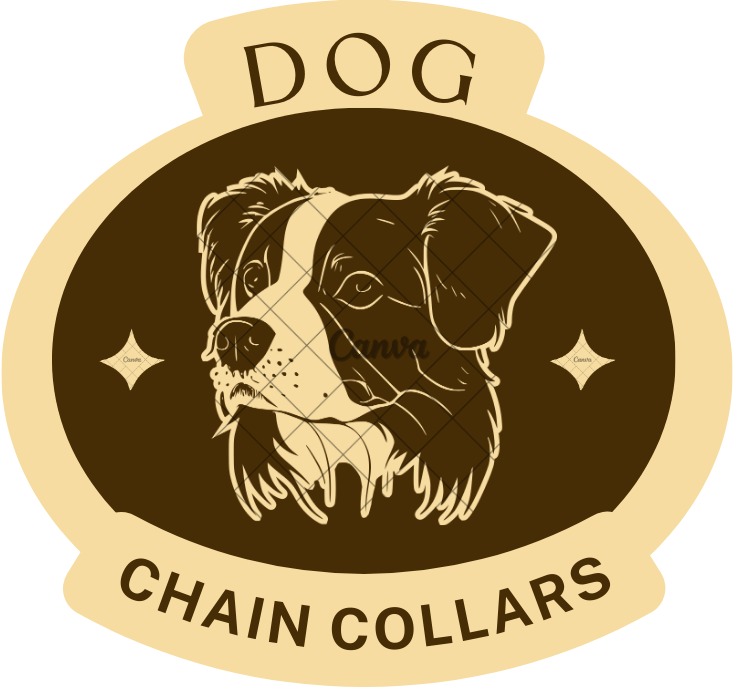Introduction
Dog chain collars have evolved beyond their traditional role as mere restraints, finding specialized applications in addressing specific behavioral issues. This explores the diverse functionalities of dog chain collars, emphasizing their special usage in various scenarios.

Bark control chain collars
Though several types of collars are available to control excessive or unwanted barking but none of them address the main cause of the barking. Dogs bark for several reasons, fear or territorial behavior. Important is that some bark collars may reduce barking, they will not reduce the stress causing the dog to bark.
Spraying
Although Barking causes these collars to emit a burst of citronella or air, which interrupts and deters your dog from barking. Spray collars will sometimes not react to high-pitched barks, making them in effective. So these are the important precautions: Don’t use a spray collar when your dog is with other dogs. Another dog’s bark may trigger your dog’s collar.
Ultrasonic Signals
When your dog barks, the ultrasonic collar interrupts them by emitting a sound only your dog can hear.
Flat dog chain collar
Flat dog chain collars are the standard collar. These collars are typically made of nylon, rubber, or leather and also lay flat against the your dog neck.
Harness Collar
A dog harness attaches around your dog body rather than the neck. Harness collar is a popular choice for small dog breeds. They place little strain on your dog neck and are hard to slip out of.
Limited-slip collar
Limited-slip collar is the martingale collar is a cross between a slip collar and a regular collar. Martingales allow you to have greater control over your dog. They are ideal for dog breeds with narrow heads—such as Greyhounds or Whippets—who are at greater risk of slipping out of a flat collar. They slip around your dog’s head and are worn high on the neck, just below the jawbone. When the dog puts tension on the leash, the leash tightens to an extent. When the dog relaxes, the collar loosens again. A martingale collar isn’t a complete replacement for a flat collar, and it’s best not to leave an unsupervised dog with a martingale collar in case it gets caught in something
Head Collar
Also known as a head halter or halter collar, head collars slip over your dog’s snout and attach with a clasp behind their ears. They’re a good option for gently training your dog to remain focused while on a walk. Their unique design places less pressure on your dog’s trachea and makes it more difficult for dogs to bark or pull while walking. However, like all training tools, they don’t work well for all dogs (some dogs can panic or become overly subdued) and should be used with proper guidance.
Slip chain collar
These collars are also known as a choke chain collar or choke collar, slip collars are designed to tighten around your dog’s neck when they pull on the leash. The sensation is meant to alert your dog to stop placing tension on the leash. Though effective if used correctly, slip collars present a choking hazard and can put undue strain on your dog’s neck and trachea.
Prong chain collar
Prong collars, also known as pinch collars, are made of metal and feature fang-shaped prongs that dig into or pinch your dog’s neck when taut. Prong collars are controversial, and many animal welfare groups advise against using them. Misuse of a prong collar can cause severe damage to your dog’s neck and trachea
E-collar
Colloquially known as “shock collars,” the e-collar is a dog training collar that works by delivering an electric pulse via metal contact points on the inside of the collar. It may be used to prevent a dog from leaving a specified area. Some models can be remote-controlled and are designed to get a dog’s attention via electric pulses, vibrations, or tones. There’s a lot of debate around the efficacy and safety of e-collars, and they should only be used with guidance from a professional dog trainer.

In conclusion, the special usage of dog chain collars extends beyond traditional functions, presenting innovative solutions to address various canine behaviors. Careful consideration and professional guidance are crucial when selecting and using these collars to ensure the well-being of our canine companions.
When using dog chain collars, begin by acclimating your dog slowly, associating it with positive experiences to foster comfort. Ensure a correct fit for safety and avoid over-tightening. Focus on consistent, gentle corrections to communicate effectively. Utilize short training sessions for optimal results, keeping the overall experience positive. Always monitor your dog’s behavior for signs of stress and adjust training accordingly.
For more in-depth guidance on using dog chain collars and enhancing your training approach, click here.

